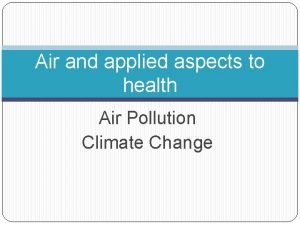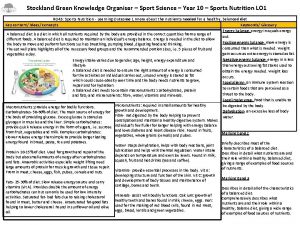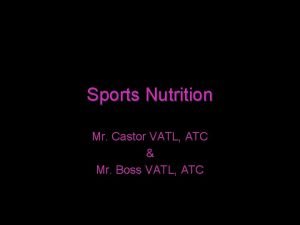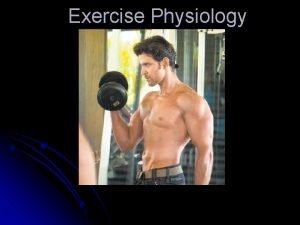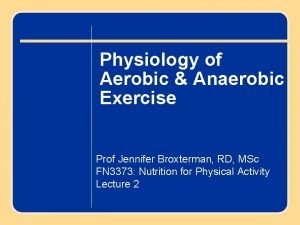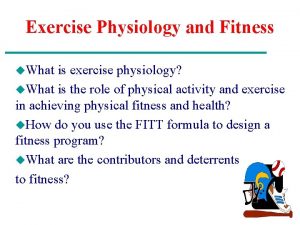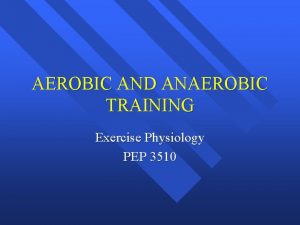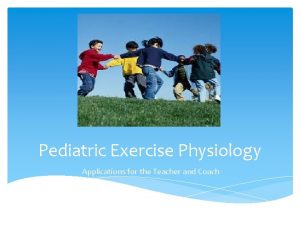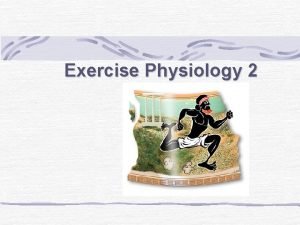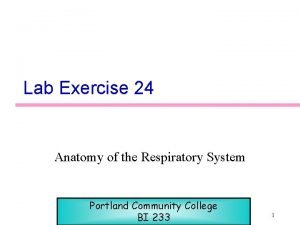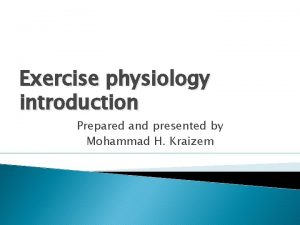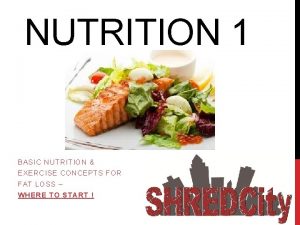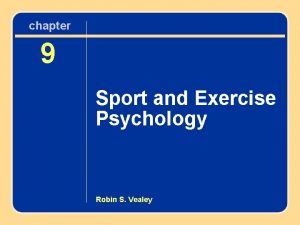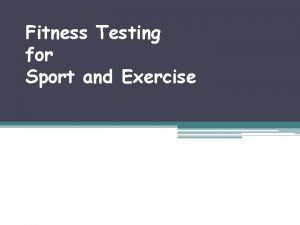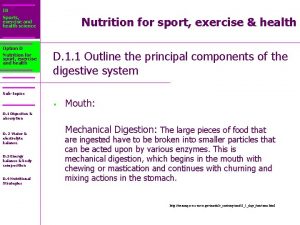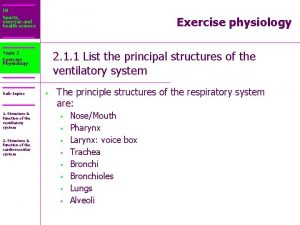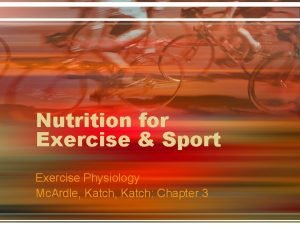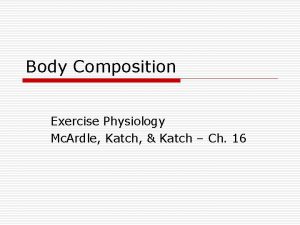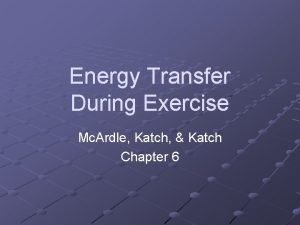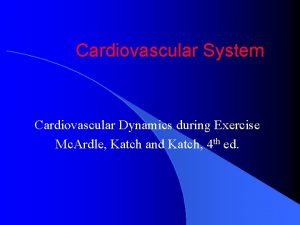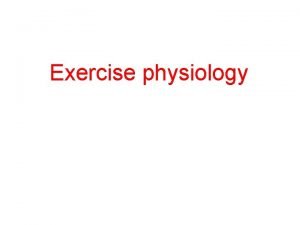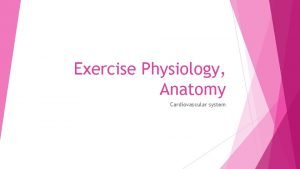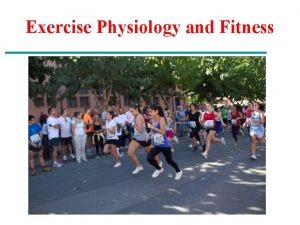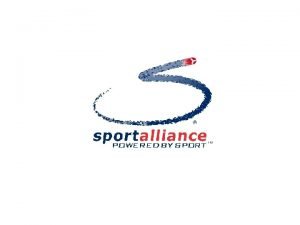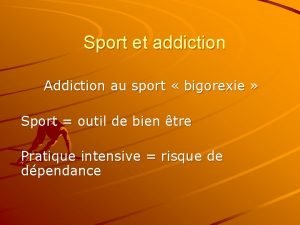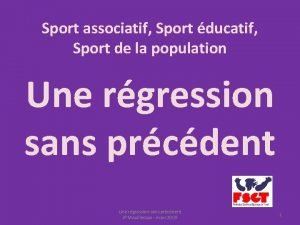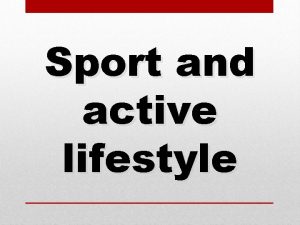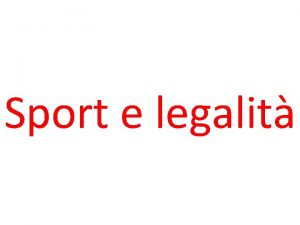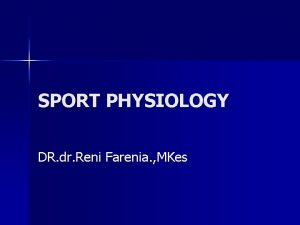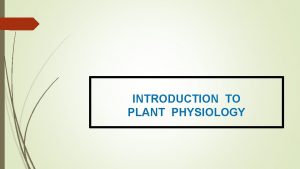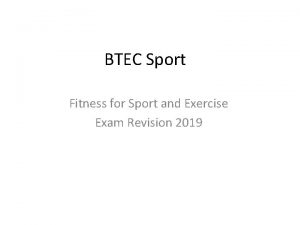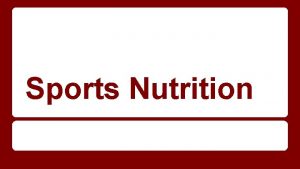Nutrition for Exercise Sport Exercise Physiology Mc Ardle





























- Slides: 29

Nutrition for Exercise & Sport Exercise Physiology Mc. Ardle, Katch: Chapter 3

Overview • Nutrient Consumption: Fit & Non-fit • Dietary Reference Intakes • Calorie and Macronutrient Needs – Pre workout (competition) Meal – Water – Carbohydrate – Fat – Protein • Adding Mass: Gaining Weight

Nutrient Consumption: Fit • Active people do not require additional nutrients beyond those obtained in a nutritionally well balanced diet. • What physically fit actually eat. – Small differences in energy intake (low v high) – Higher dietary fiber & lower cholesterol intakes – Diets more closely approach recommendations • Sound human nutrition represents sound nutrition for athletes.

Performance Factors • Genetics • Training and Conditioning • Nutrition

Determinants of the Athletes Energy Requirements • During intense exercise – Carbohydrates are stored in muscles and liver are the predominant fuel source • During Prolonged exercise – Fat stores are the predominant fuel source

My Pyramid Replaces Food Guide • My Pyramid replaces Food Guide Pyramid to provide food intake guidance based on age, sex, and level of daily exercise. • Recommend consuming between 45% and 65% of total calories from CHO. • Recommend consuming between 20% to 35% of total calories from Fat. • Recommend consuming between 10% to 35% of total calories from Protein. • Recommended meal composition includes 60% CHO, 25% protein, 15% Fat (Institute of Medicine).

Exercise and Food Intake • Most obvious distinction in nutrient needs between active and inactive is more total calories. • Except for high energy intake at extremes, daily intake does not exceed 4000 k. Cal for men and 3000 k. Cal for women.

Exercise and Food Intake • Phelps told ESPN he eats roughly 8, 00010, 000 cal/d, including lots of pizza & pasta. • Breakfast of champions – – – 3 fried egg sandwiches 2 cups coffee 5 -egg omelet 1 bowl grits 3 slices French toast 3 chocolate chip pancakes Beijing 4 x 100 freestyle relay, 8 -11 -08

Exercise and Food Intake • To support 6’ 4”, approximately 190#, training regimen requires ~1, 000 cal/hr while training or racing. • Probably eats closer to 6, 000 cal/day.

Formula for Estamating the Body’s Calorie Requirements • Sedentary person – Weight(kg) x 25 • Moderately active – Weight(kg) x 30 • Active – Weight(kg) x 40 • Underweight person – Weight(kg) x 45

Exercise and Food Intake Minimum: current wt (lb) X 23 = total calories for males • Current wt (lb) x 20 = total calories for females • Relatively high caloric intakes of physically active men & women usually increase protein, vitamin, and mineral intake above normal. • Percentage of calories from energy nutrients should remain in normal ranges.

Precompetition Meal Pre-workout meal goal: maximize muscle & liver glycogen stores providing glucose for intestinal absorption during exercise & enhance hydration. – Be consumed within 3 -4 hours before exercising sufficient time to digest & absorb. – Reasons precompetition meal high in CHO: • Foods high in lipid & protein digest slowly • Low CHO meal can hinder performance

Carbohydrate Needs* • Carbohydrate is the optimal fuel for exercise • Prolonged and intermittent, intense training depletes carbohydrate (glycogen) stores resulting in poor performance and fatigue. • Consume carbohydrate with every meal. • In general, carbohydrates (CHO) should always provide at least 55% of total daily calorie (TDC) intake. Ideally 60 -70% of TDC.

Carbohydrate Needs* More intense or prolonged training requires more carbohydrate • • 3 grams/lb body weight for 1 hour training 4. 5 grams/lb body weight for 2 hours training. 5 grams/lb body weight for 3 hours training. 6 grams/lb body weight for 4+ hours training. How many calories per gram of CHO? Sources: Bread, Tortillas, Bagels, English Muffins, Cereals, Rice, Pasta, Vegetables, Potatoes, *Fruit, Fruit Juices, Sports Drinks, Soda Pop, Crackers, Pita, Pretzels, Popcorn

Carbohydrate Needs Before exercise – pre-exercise fructose absorbs more slowly, but GI distress – consuming rapidly absorbed, high glycemic CHO w/i 1 hr before exercising accelerates glycogen depletion by causing insulin overshoot & rebound hypoglycemia. – consuming low glycemic CHO immediately (< 30 min) allows for relatively slow absorption.

During Exercise • During exercise: 30 -60 grams per hour, 510 oz of 5 -8% CHO electrolyte drink every 15 -20 min or 2 gels per hour; drink contributes to temperature regulation

After Exercise After exercise – To speed up glycogen replenishment, consume 50 -75 g moderate to high glycemic index w/i 15 minutes. – Under optimal CHO intake, takes 20 hrs to replenish glycogen stores at rate of 5% per hour.

Carbohydrate Needs in Intense Exercise* • Successive days of intense training gradually deplete glycogen reserves even with typical CHO intakes: staleness. • High CHO diet (80% of caloric intake) for 3 days increased muscle _______ and endurance time.

Carbohydrate Loading Glycogen Loading: procedure increases muscle glycogen levels more than normal (1. 7 g/100 g). – Normal amount of glycogen packed in muscle: 5 g glycogen/ 100 g muscle • What is major benefit of carbohydrate loading? – Endurance capacity – Unless athlete begins competing completely depleted, exercise < 60 min requires normal carbohydrate intake • What is major drawback of glycogen loading? – Each gram glycogen stores 2. 7 grams H 2 O, makes “heavy” fuel.

Carbohydrate Loading • Classic Carbohydrate Loading – Stage 1: depletion • Day 1: perform exhaustive exercise to deplete • Days 2, 3, 4: Maintain low CHO food intake – Stage 2: loading • Days 5, 6, 7: maintain high CHO food intake – Stage 3: competition • Modified Loading • Days 1 -3: exercise @ 75% VO 2 max, 1. 5 hrs, 50% CHO • Days 4 -6: taper exercise duration, 70% CHO

Fat Needs* • Too much can cause cramps • Not enough can cause fatigue more quickly • Try to limit high fat foods before and during exercise. • Foods to avoid before & during exercise: chips, ice cream, nuts, nut butters, french fries, doughnuts, fried meats, pizza, chocolate, bologna, salami, pepperoni, burgers • In general, limit TDC intake < 30% fat.

Protein Needs* • Body can’t use more than 1 gram of protein per pound of body weight! • Not immediately available as an energy source for exercise. • Important for recovery and to boost immune system. • Sources: chicken, turkey, soy burgers, fish, eggs, dried beans, beef, cheese, nuts and nut butters, pork, milk, veal, shellfish • In general, 15 -20% TDC intake.

Periodization of Calorie Needs*

Baseball Guidelines*

Basketball Guidelines*

Football Guidelines*

Nutrient Timing Resistance Training • Energy Phase: immediately pre- & during exercise period consume high glycemic CHO & rapidly digested PRO supplement. • Anabolic Phase: consume high glycemic CHO/PRO in liquid form during 45 -minute post-exercise. • Growth Phase: from end of anabolic to beginning next workout, high glycemic CHO and high PRO intake.

Goals* Adding Mass • Goals for weight & strength gain = 1 lb/wk • 10 -14 additional grams protein/day 1 lb muscle mass/week • Goals to add 500 -100 additional calories/day • Increase number of meals, not just size meals • Don’t rely on weight gainers or high protein powders. Fill you up before get in all calories

Illustration References • Mc. Ardle, William D. , Frank I. Katch, and Victor L. Katch. 2000. Essentials of Exercise Physiology 2 nd ed. Image Collection. Lippincott Williams & Wilkins. • Plowman, Sharon A. and Denise L. Smith. 1998. Digital Image Archive for Exercise Physiology. Allyn & Bacon. • Carmichael, Chris. 2005. The Lance Armstrong Diet, Men’s Journal, Aug. p. 38.
 Mc ardle’s maximum allowable sweat rate is
Mc ardle’s maximum allowable sweat rate is Physiology of sport and exercise 5th edition
Physiology of sport and exercise 5th edition Unit 26 animal anatomy physiology and nutrition
Unit 26 animal anatomy physiology and nutrition Unit 26 animal anatomy physiology and nutrition
Unit 26 animal anatomy physiology and nutrition Nutrition sport
Nutrition sport Boss sports nutrition
Boss sports nutrition School of exercise and nutrition sciences
School of exercise and nutrition sciences Map=co x tpr
Map=co x tpr Exercise physiology for health, fitness, and performance
Exercise physiology for health, fitness, and performance Exercise intro chapter 1
Exercise intro chapter 1 What is fitness
What is fitness Exercise physiology quiz
Exercise physiology quiz Pep 3510a
Pep 3510a Pediatric exercise physiology
Pediatric exercise physiology Isometric exercise physiology
Isometric exercise physiology Trachea
Trachea Define exercise physiology
Define exercise physiology Uk myeloma forum
Uk myeloma forum Nutrition and exercise concepts
Nutrition and exercise concepts Exercise psychology definition
Exercise psychology definition Fitness testing for sport and exercise
Fitness testing for sport and exercise Sport exercise and health science ib
Sport exercise and health science ib Institute of sport exercise and health
Institute of sport exercise and health Ib sport exercise and health science
Ib sport exercise and health science Ministerstyre för och nackdelar
Ministerstyre för och nackdelar Var finns arvsanlagen
Var finns arvsanlagen Claes martinsson
Claes martinsson Sju principer för tillitsbaserad styrning
Sju principer för tillitsbaserad styrning Nyckelkompetenser för livslångt lärande
Nyckelkompetenser för livslångt lärande Bunden poesi
Bunden poesi
